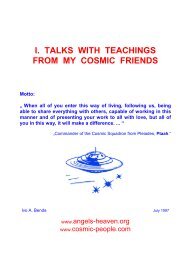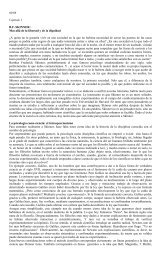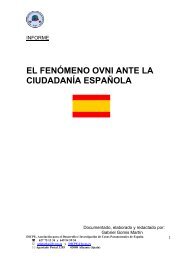The Word That is God
The Word That is God
The Word That is God
Create successful ePaper yourself
Turn your PDF publications into a flip-book with our unique Google optimized e-Paper software.
ecome a jivanmukta. It enables one to meditate upon Brahman, increases the prana, and<br />
awakens the mind–for it ar<strong>is</strong>es from Shiva. Being the root of all mantras, and being the form<br />
of the Primal Being, it <strong>is</strong> known as the mula [root] mantra. Because of its subtle and causal<br />
nature, and on account of its state of repose and mobility and its being indicative of the<br />
transcendent Ishwara, it <strong>is</strong> known as the Linga [symbol]. On account of its presence in all<br />
beings, at all times, and its indicating the form of Brahman, it <strong>is</strong> called the Thread [sutra].”<br />
(Yogashikha Upan<strong>is</strong>had 2:5-11)<br />
Om, the embodiment of all divine qualities (being divine Itself), has the power to impart<br />
those qualities to us who invoke It. Here, too, we see that the effect of Om <strong>is</strong> not abstract or<br />
confined only to the highest levels, but It benefits–through evolution–all the aspects of our<br />
being. According to the upan<strong>is</strong>had Om increases the life force and expands the mind.<br />
In th<strong>is</strong> and all passages regarding the nature of Om the word translated “symbol” does not<br />
mean a mere sign or symbol in the usual Engl<strong>is</strong>h sense–the way the word “water” <strong>is</strong> not really<br />
water itself. Rather it means indicator in the sense that Om <strong>is</strong> a form of Brahman that actually<br />
puts us in direct touch with Brahman. It not only points out Brahman but attunes and joins us<br />
to Brahman, being Itself Brahman.<br />
As the gems of a necklace are held together by the string that passes through their midst,<br />
so Om <strong>is</strong> the “thread” of all ex<strong>is</strong>tence.<br />
“Pranava <strong>is</strong> of the nature of Prakriti [all creation], as <strong>is</strong> borne out by the scriptural<br />
statement, ‘Knowers of Brahman say that the Pranava ar<strong>is</strong>es out of the Supreme Being as<br />
Prakriti.’ <strong>The</strong> Pranava <strong>is</strong> that by means of which the universe <strong>is</strong> sustained. By the repetition of<br />
the Pranava the Turiya-Turiya Brahman flashes forth in the form of the non-relative atman.”<br />
(Yogashikha Upan<strong>is</strong>had 2:13,14)<br />
“<strong>That</strong> transcendent radiance <strong>is</strong> Om in Which there stand all the worlds and Brahma,<br />
V<strong>is</strong>hnu, and Shiva, all the worlds, all speech, and the Vedas.” (Yogashikha Upan<strong>is</strong>had 6:56,57)<br />
A Yoga Upan<strong>is</strong>had<br />
“<strong>The</strong> Turiya-Turiya, the Brahma Pranava [Om], establ<strong>is</strong>hes Itself as the imper<strong>is</strong>hable. In<br />
th<strong>is</strong> substratum of the transcendent Brahman, knowers of the Vedas, intent on attaining their<br />
beatitude, seek final repose by becoming one with It.” (Th<strong>is</strong> <strong>is</strong> from one of the Yoga Upan<strong>is</strong>hads,<br />
but I failed to get the reference.)<br />
Turiya-Turiya means “the consciousness of consciousness,” the absolute substratum of<br />
reality: the Absolute. Sri Upan<strong>is</strong>hadbrahmayogin comments that Pranava “establ<strong>is</strong>hes Itself as<br />
the imper<strong>is</strong>hable” by “causing the d<strong>is</strong>solution of all perceptions apart from Itself which are<br />
per<strong>is</strong>hable and which, though originally considered as the support of all things apart from<br />
Itself, proves, on closer scrutiny, to be itself the Unsupported [Brahman].”<br />
<strong>The</strong> Puranas<br />
Purana literally means “<strong>The</strong> Ancient.” <strong>The</strong> Puranas are a number of scriputres attributed<br />
to the sage Vyasa that teach spiritual principles and practices through stories about cosmology<br />
and sacred h<strong>is</strong>torical personages which often include their teachings given in conversations.<br />
53
















